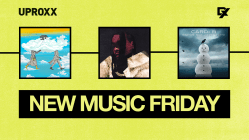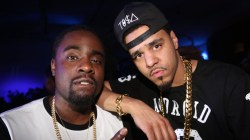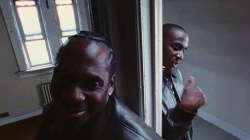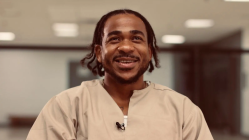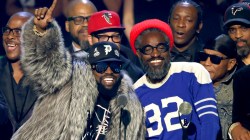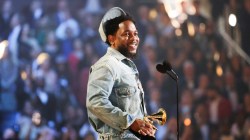
In one of Hip Hop journalism’s most epic quotables, Chuck D referred to rap music as “CNN for black people.” For all racial and social minorities, I strongly hope this is still the case. I’m eager to see what Immortal Technique, Murs and P.E. themselves will offer people in what remains of 2008. Still, I equally believe that rap, when it’s done right, can just as much be a Travel Channel for us all.
One of my favorite records of all time is Black Star and Common’s “Respiration.” In the brooding account of urban life, Common said it best “I asked my God how’ he thought travelin’ the world sound / Found it hard to imagine, he hadn’t been past Downtown.” I don’t underplay this for any of us. Although I’ve spent time in over half of the United States, I still don’t own a passport. There’s so many places to go, and I often to turn music – as well as film, literature and art to teach and reach me.
As The Roots released yet another gem this year in Rising Down, I’m tickled at what the group’s production and Black Thought’s bars tell the people of the world what’s going on in the city that I currently live in. It’s hard to top “Game Theory” [click to read] or “Push Up Ya Lighter” [click to read] as accurate capsules of a day in the life in the land of the Illadelph. The train stops, the street name shout outs, and most of all, the adjectives that Thought has always used to describe the people here, whether store owners, hustlers, killers or fans with hands in the air, are brutally honest, unflinching accounts as I’ve come to see it. Perhaps one is a reaction to the other, but Freeway, Will Smith and Reef The Lost Cauze have emphasized this as well.
Growing up, my time spent in California was limited to the usual tourist spots in one 1993 trip. Although Cali goes beyond lowriders and nine millimeters tucked into the waistband of Joe Boxer‘s, I was exposed to many facets of the city, whether image-heavy efforts like Ice Cube’s “It Was A Good Day,” Above The Law’s “Black Superman” or Dr. Dre’s “Let Me Ride.” These were attitudes, backed by matched music of a ‘90s Los Angeles that will forever be chronicled in documentaries and history books for its social unrest and depravity as a result of crack cocaine. Cube, Hutch and Andre were my travel-guides, and while much of the masses laid lost in hot tracks, think about what these efforts really enforced into our minds of a tangible culture. Notice how that Los Angeles evolved by the time 2Pac made “To Live and Die in L.A.” The riots had cooled down, and ‘Pac pushed for cultural unity, amidst a city still trying to overcome its violent tendencies. As I drove with Makaveli in the car last week, that’s the album’s one efforts that oddly find troubling, as it still seems to be relevant today.
Hand in hand, I truly admire the work of Evidence. Rather than delve into the trite subject matter of the Los Angeles we all knew from the gangsta rap era, the cultural diversity of a Venice Beach existence comes across in his solo work and with Dilated Peoples. I often struggle with the sense of escapism that Hip Hop finds demand in ghetto rhymes that we often overlook the beautiful places we all live or spend time in. The same is true of Pharcyde, Murs and Project Blowed. No place is exactly one thing, and together, these movements seem to accurately complement each other for a proper composite of what Los Angeles was – just as U.N.I., Pacific Division and Blu do today, set against the contemporary editions of Compton and Long Beach life from The Game and Crooked I respectively. I sample both worlds, and long await for my next journey to the coast to the left.
Atlanta remains an enigma to me. Admittedly, I have spent much less time in the A than L.A., Chicago or New York. However, Atlanta fascinates me. I feel like I can understand it. The Dungeon Family, as one entity, has given me a tour of the place I feel I know so well. Yes, there is violence – mostly knuckles to the eye and shoving in the club, but the more laid back environment comes across in the captured creativity and subdued beats that many of us simply thought Andre 3000 was lying when he waved off drugs and alcohol. “Elevators” is an Atlanta afternoon, with big dreams and bold creativity. Across town and a decade later, T.I. and Toomp’s “What You Know” achieves those dreams, and steps on anybody that’s late with the respect. Moreover, the anthem incorporates the strip club music that sustained the city’s reputation for so long, and defiantly brings it back to the Kilo-era of gangsterism from the same city. With money, comes trouble. Whether it’s Tip, Jeezy or Shawty Lo, the new class is ready for suitors getting out of pocket. You can see this in B.o.B., who impresses me for his accessibility to both sides of the city. A leader is born, and with the also burgeoning hipsterism going on down there, a young, fashionable and musical chameleon is on the pulse of what this outsider perceives is going on.
I haven’t been to Chicago in five or six years – I certainly wasn’t there in the Kanye West or Lupe Fiasco era, but when Common was – and still is – king. This was before “Corners,” which is a brilliant reflection of his streets, and universal streets, to us all. At that time, I was able to better understand, how from the same area code, Common and Malik Yusef could make the brilliant “My City” while Crucial Conflict‘s “Hey” are in the same vain. Different attitudes, different life perspectives, different plans of action, but just as the choices made on the streets, neither is more justified than the next. Whichever side of Chicago delivers the Hip Hop that I’m listening to at the time, I can feel the wind, see the Cadillacs and I almost always get hungry for some of that city’s incredible cuisine – though “The Food” was misleading in its title, about that.
As I write this, I have little doubt that Grand Theft Auto is educating many outsiders on what New York City is like. Although there’s far more traffic, ugly cars and much worse radio in the real thing, I’m okay with this lesson. For me, I really looked at the individual movements to understand not only the Big Apple, but its five distinct pieces that make it so tempting.
I cannot fathom a group more Brooklyn than Black Moon. Buckshot, Evil Dee and 5FT embody the Timberland-stomping, spittin’ on the sidewalks, but highly-educated and spiritual essence of the BK. Less than 10 miles away, Reasonable Doubt is more visual than Clockers in its hustling-driven explanation of ways to get money in the biggest borough. These are the kids getting money in their borough and spending it in Manhattan clubs. Then there’s M.O.P., Non-Phixion and El-P all representing other attitudes and styles, reflective of their various neighborhoods. Where Cosby Show only took me so far, Brooklyn came alive under the needles, from verses that made me touch the Brownstones and taste the beef patties.
Without going into each of the five boroughs of New York – and Long Island, acts ranging from G-Unit to The Diplomats to Raekwon and Ghost and EPMD complement each other so well, and all seem to carry a connection to the places they represent. Whether it’s flashy jewels and a bigger than life ego, or Italian-influenced vernaculars and a more spacious approach to rhymes and beats, these artists embody their pieces of real estate. Moreover, they taught me worlds about their worlds, before I ever got to teach down.
I don’t really watch videos anymore, besides my bouts of YouTube nostalgia. In the last few years of my Rap City and Sucka Free Sunday consumption, I too grew tired of seeing the redundant shots of men standing on corners, showcasing women and cars, again and again. There’s King and there’s Rides magazine, which I prefer over video-after-video of this monotony. But what I really miss, and what I’m forever trying to find in the lyrics, is that authenticity of place. Rap music can be some of the illest travel-writing ever, and I’m not just talking about Ice Cube‘s “My Summer Vacation” or Nas‘ “Get Down.”
Hip Hop probably taught most of us about Roscoe’s Chicken & Waffles, about Magic City, about The Tunnel or even Saint-Tropez. We have this thing, which most of us use for entertainment and mental escapism, but we can ask more of our artists as well as give their work some lasting integrity if we credit them properly, and listen to what they’re saying about places, people and times.

